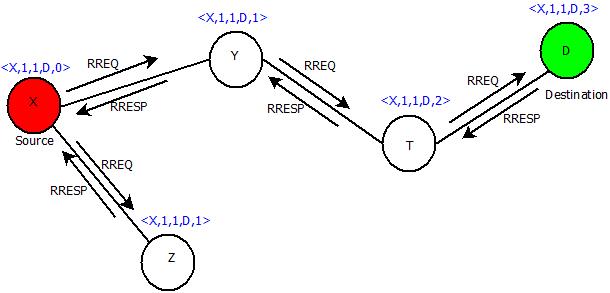Ad-Hoc On Demand Distance Vector Routing Protocol(AODV) : Introduction
- Another type of reactive routing protocol which does not maintain routes but build the routes as per requirements is Ad-Hoc On Demand Distance Vector Routing Protocol.
- AODV is used to overcome the drawbacks of Dynamic Source Routing Protocol and Distance Vector Routing Protocol i.e. Dynamic Source Routing is capable of maintaining information of the routes between source and destination which makes it slow. If the network is very large containing a number of routes from source to destination, it is difficult for the data packets header to hold whole information of the routes.
- In case of Dynamic Source Routing, multiple routes are present for sending a packet from source to destination but AODV overcomes this disadvantage too.
- In AODV, along with routing tables of every node, two counters including Sequence Number(SEQ NO) and broadcast ID are maintained also.
- The destination IP is already known to which data is to be transferred from source. Thus, the destination Sequence Number(SEQ NO) helps to determine an updated path from source to destination.
- Along with these counters, Route Request(RREQ) and Route Response(RRESP) packets are used in which RREQ is responsible for discovering of route from source to destination and RRESP sends back the route information response to its source.
Ad-Hoc On Demand Distance Vector Routing Protocol : Working
- In Ad-Hoc On Demand Distance Vector Routing, the source node and destination nodes IP addresses are already known.
- The goal is to identify, discover and maintain the optimal route between source and destination node in order to send/receive data packets and informative.
- Each node comprises of a routing table along with below mentioned format of Route Request(RREQ) packet.
RREQ { Destination IP, Destination Sequence Number, Source IP, Source Sequence Number, Hop Count}
- Consider a network containing 5 nodes that are “X”, “Y”, “Z”,”T”,”D” present at unit distance from each other, where “X” being the source node and “D” being the destination node.

Ad-Hoc On Demand Distance Vector Routing : Sample Network
- The IP addresses of source node “X” and destination node “D” is already known. Below mentioned steps will let you know how AODV works and concept of Route Request(REREQ) and Route Response(RRESP) is used.
- Step 1: Source node “X” will send Route Request i.e. RREQ packet to its neighbours “Y” and “Z”.
- Step 2: Node “Y” & “Z” will check for route and will respond using RRESP packet back to source “X”. Here in this case “Z” is the last node but the destination. It will send the RREQ packet to “X” stating “Route Not Found”. But node “Y” will send RRESP packet stating “Route Found” and it will further broadcast the RRESP to node “T”.
- Step 3: Now the field of net hop in the RREQ format will be updated, Node “T” will send back the “Route Found” message to Node “Y” and will update the next hop field further.
- Step 4: Then Node “T” will broadcast and RREQ packet to Node “D”, which is the destination and the next hop field is further updated. Then it will send RRES packet to “T” which will further be sent back to the source node “X” via node “Y” and Node “T” resulting in generation of an optimal path. The updated network would be:

Ad-Hoc On Demand Distance Vector Routing : Network
Advantages : Ad-Hoc On Demand Distance Vector Routing Protocol
- Dynamic networks can be handled easily.
- No loop generation.
Disadvantages : Ad-Hoc On Demand Distance Vector Routing Protocol
- A delayed protocol because of its route discovery process.
- High bandwidth requirement.